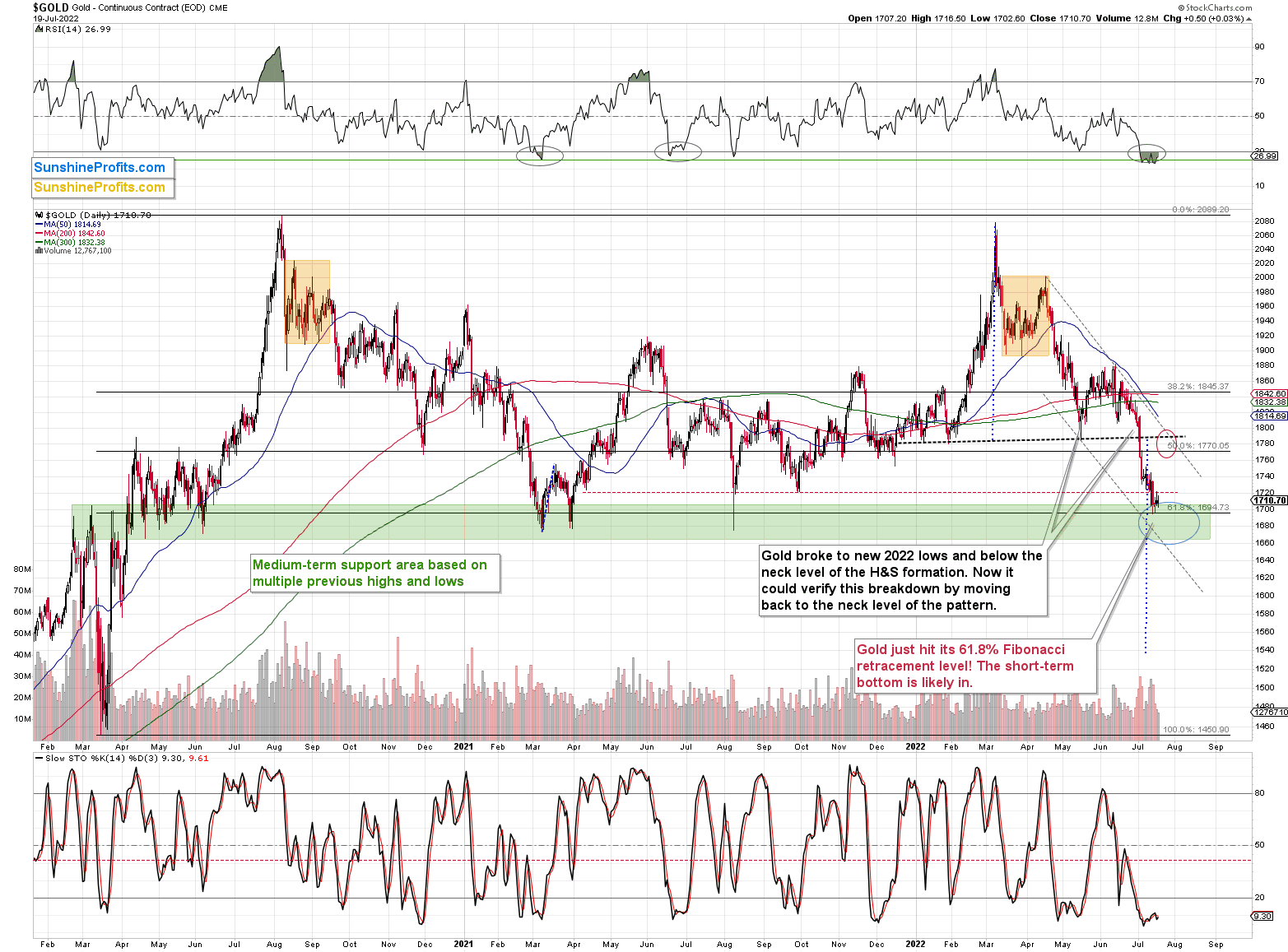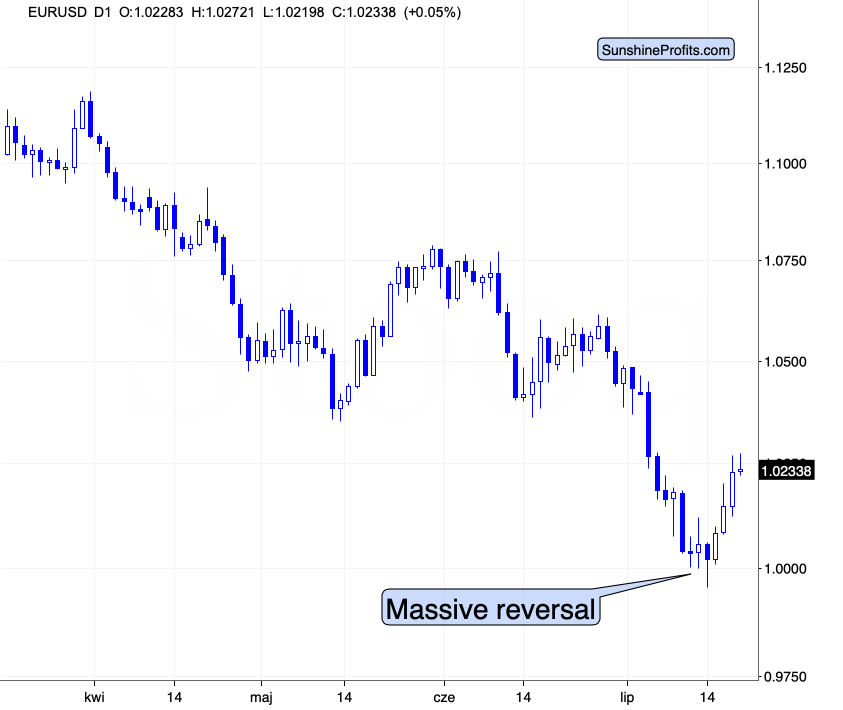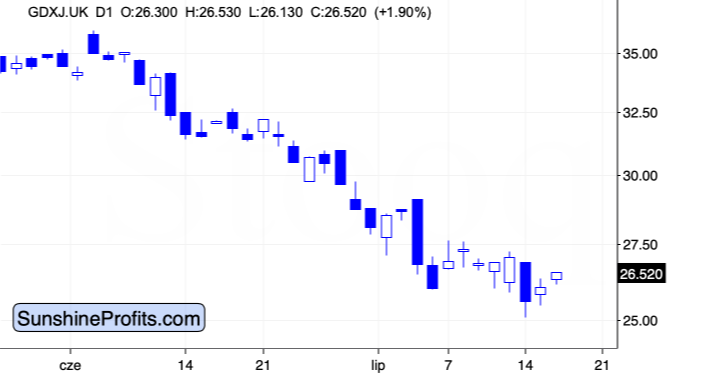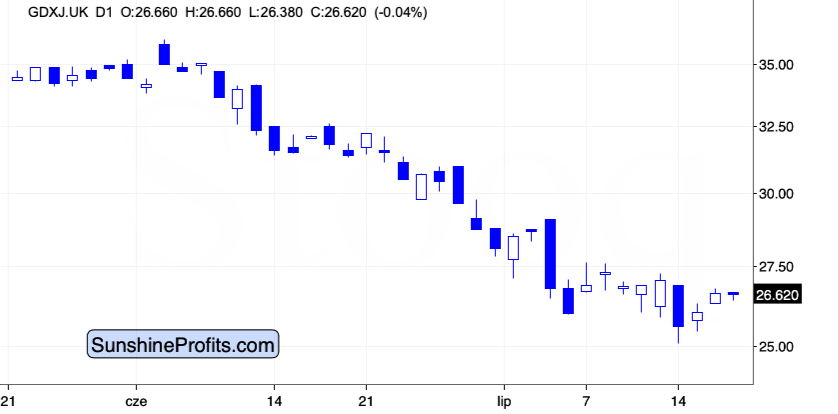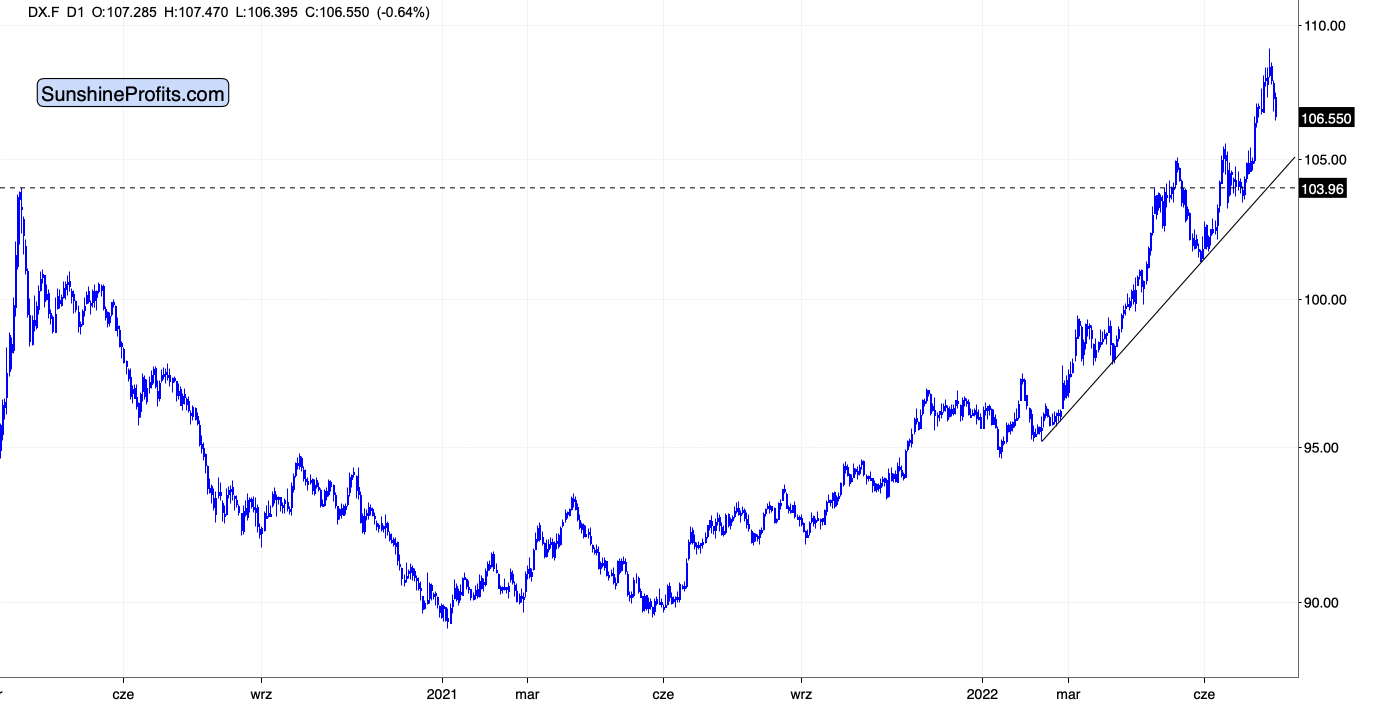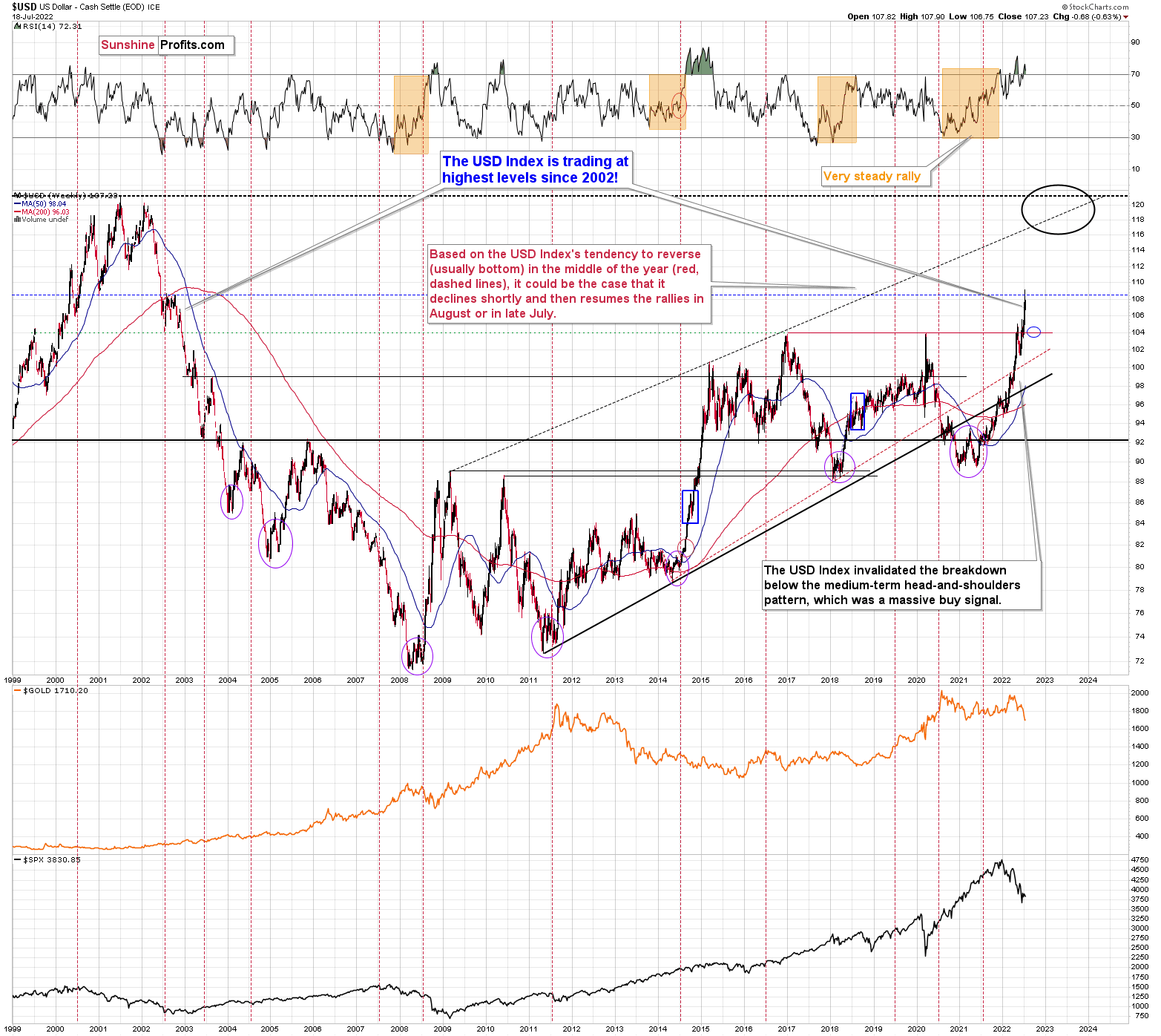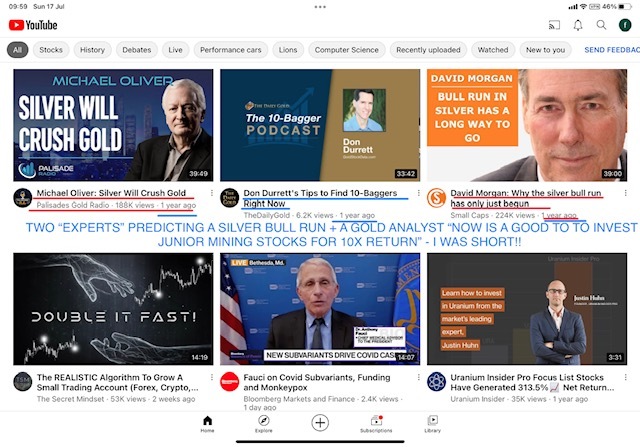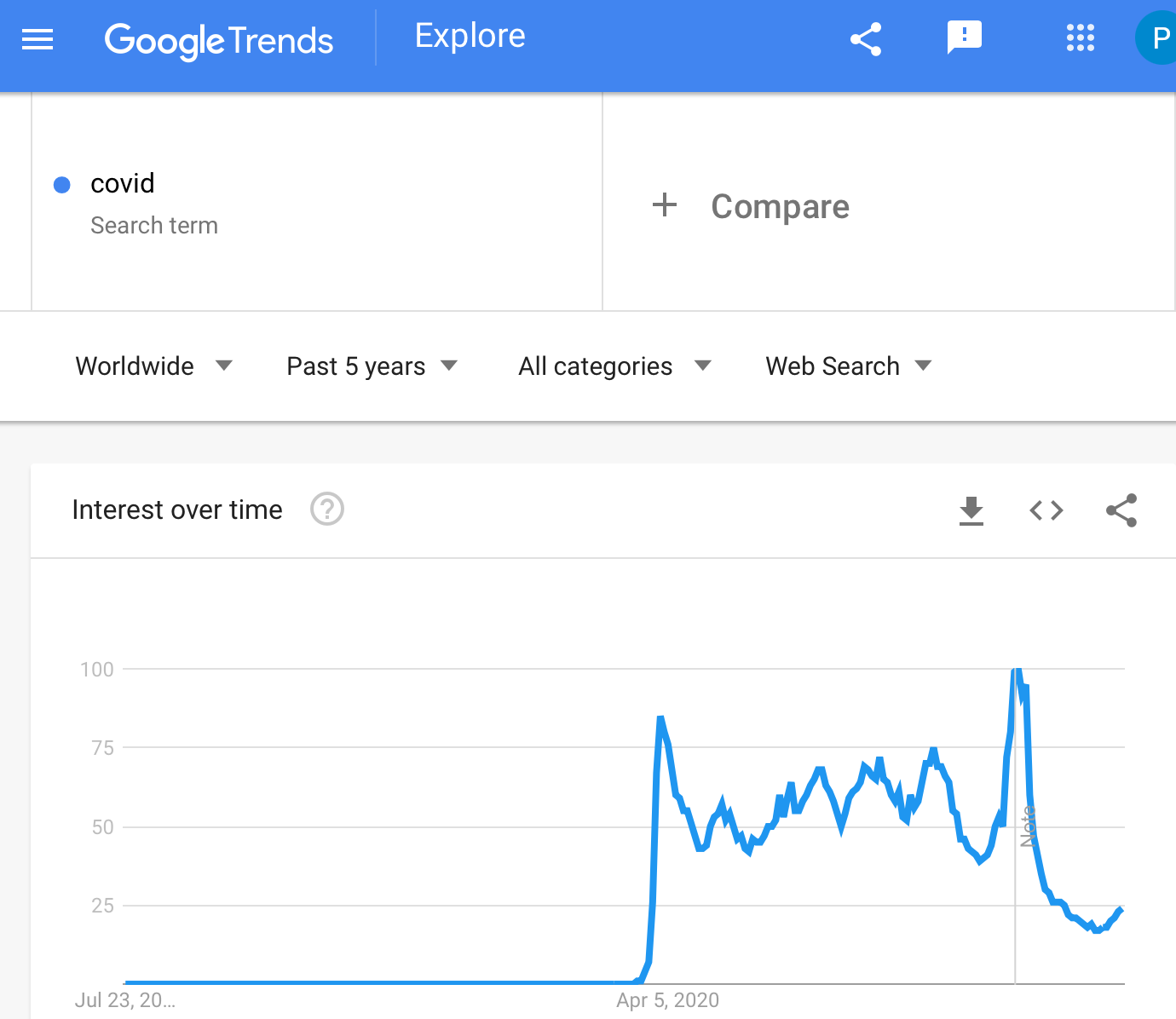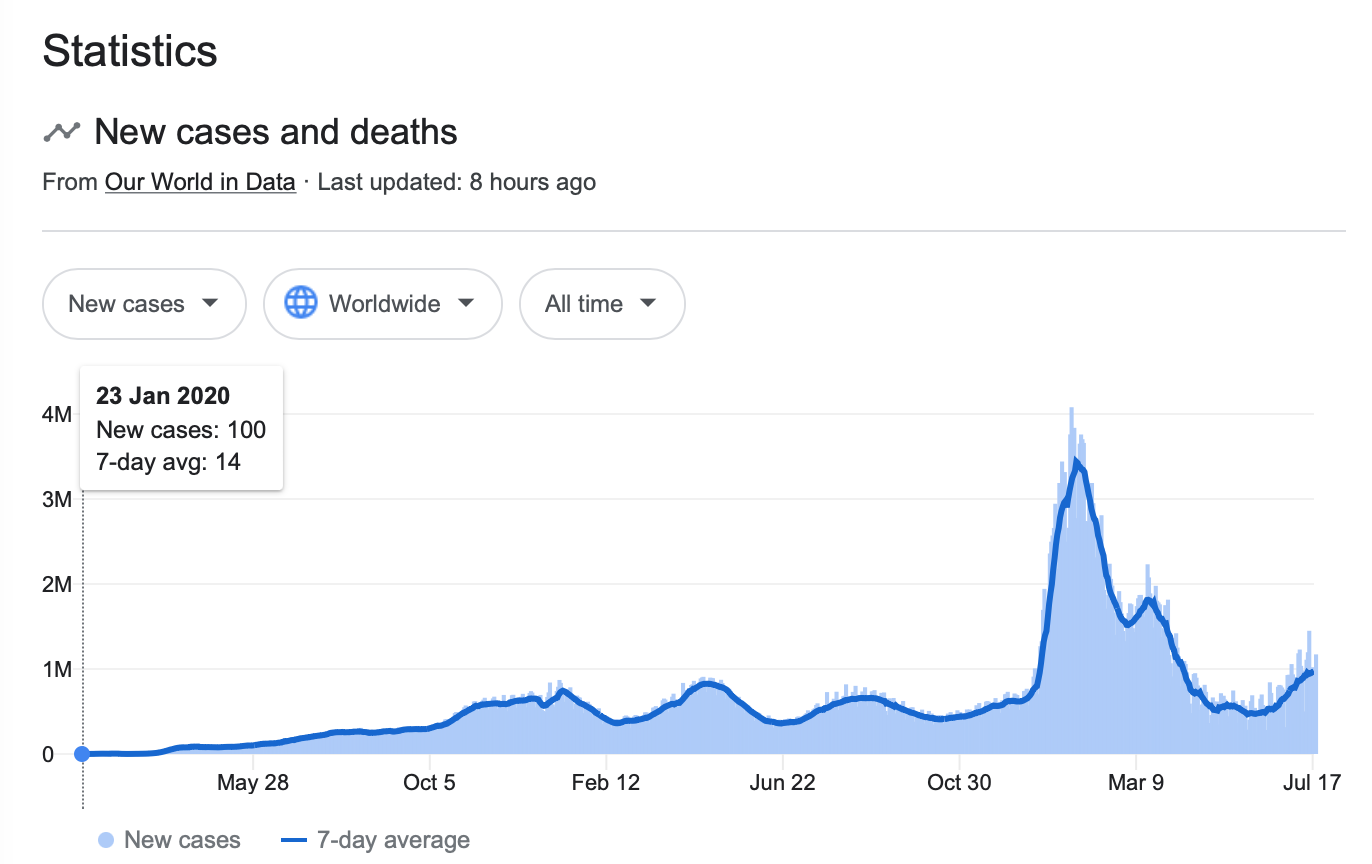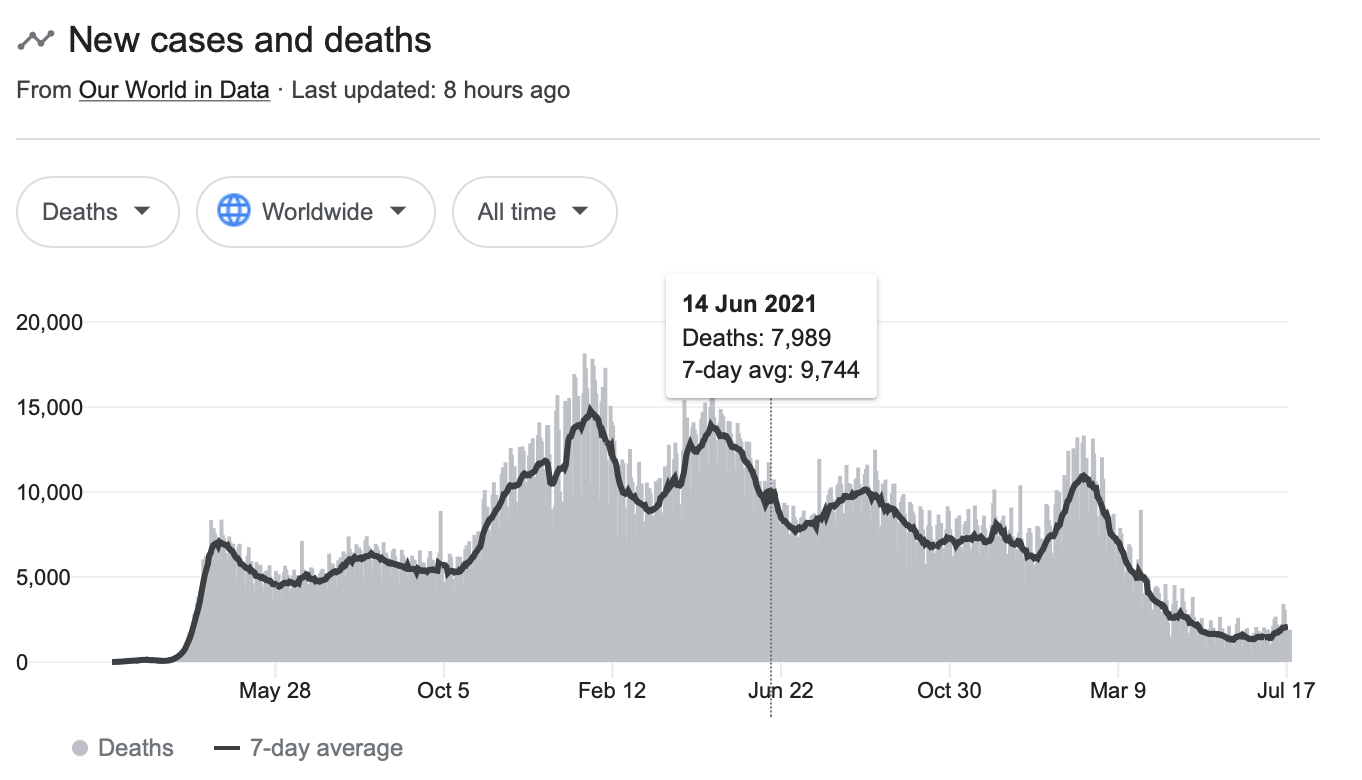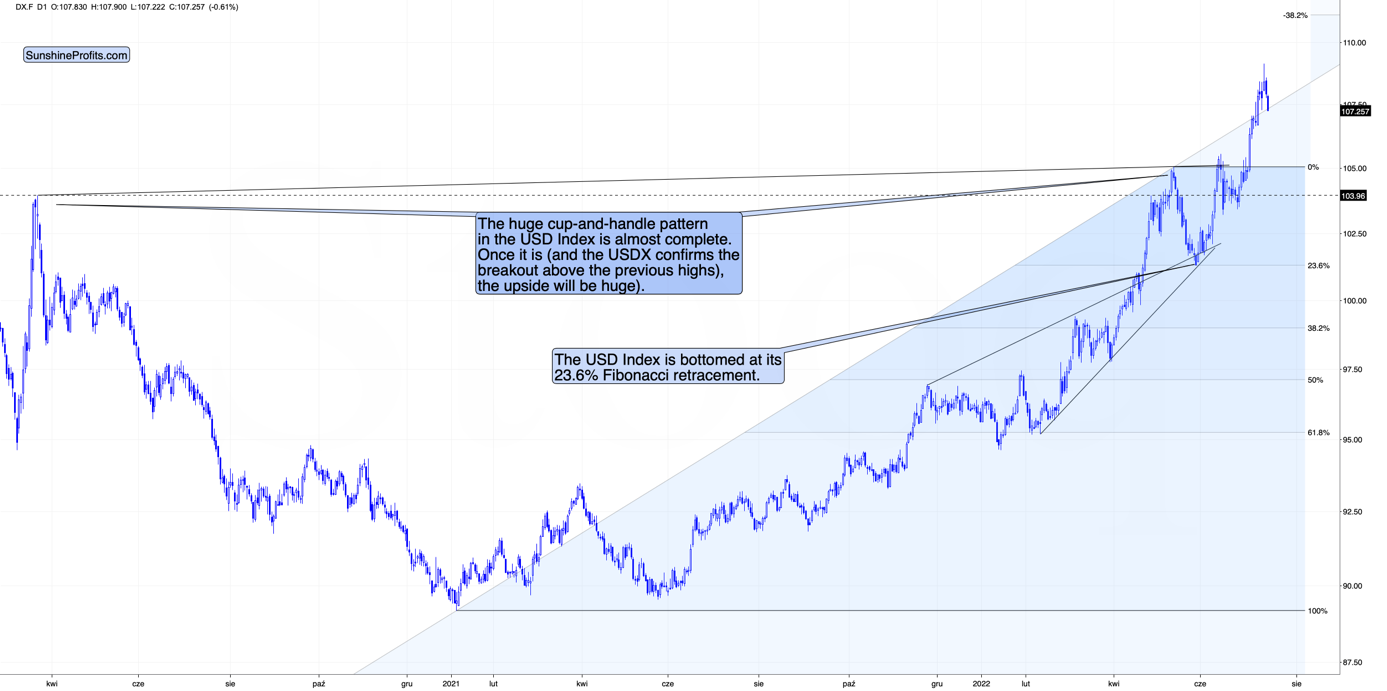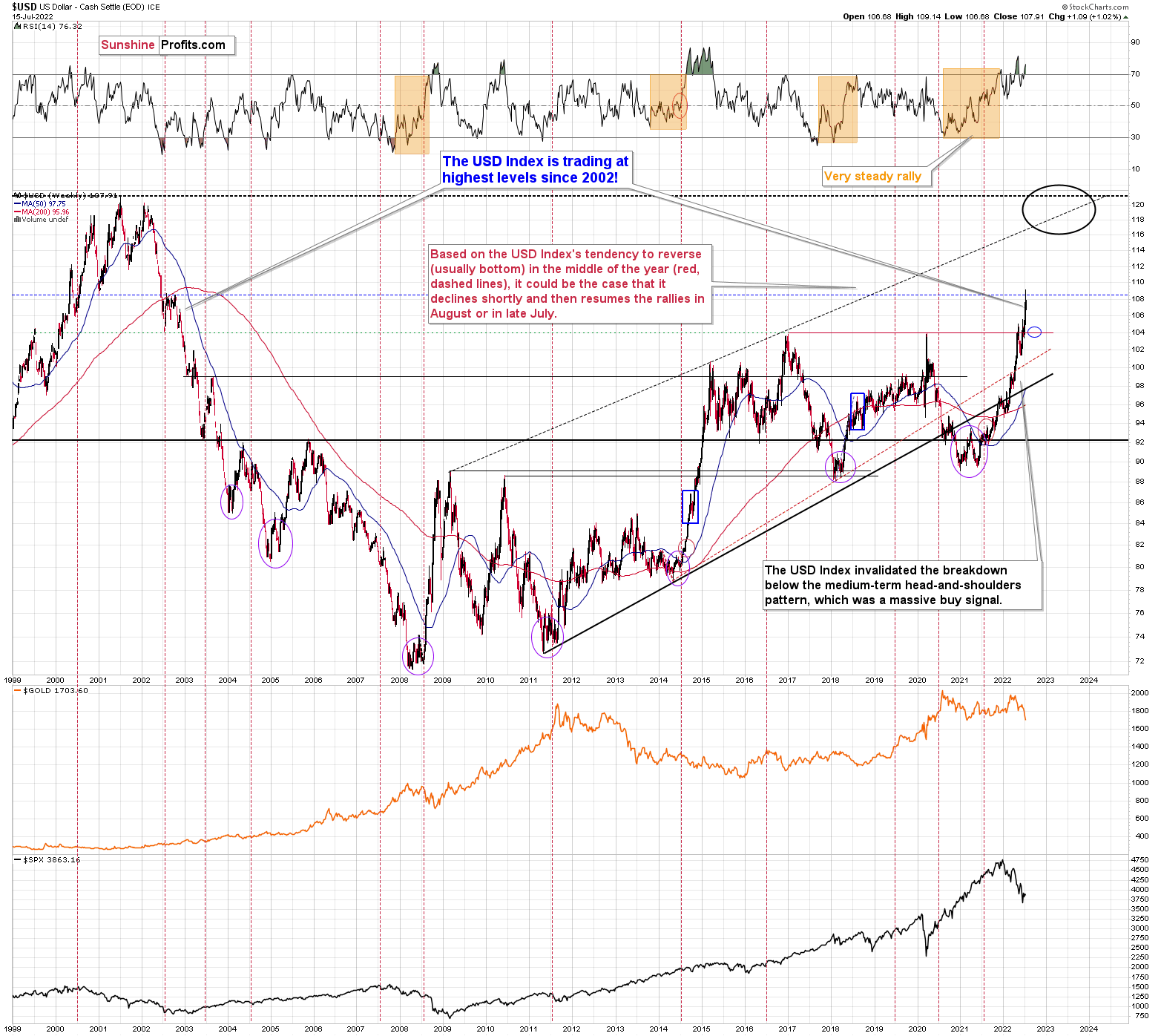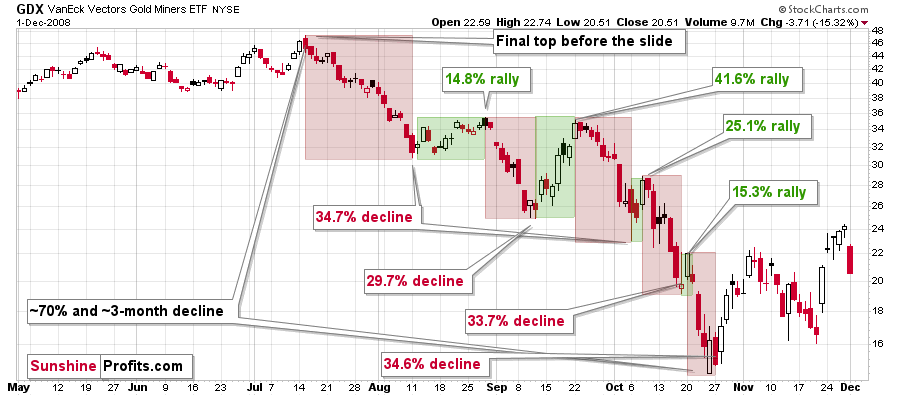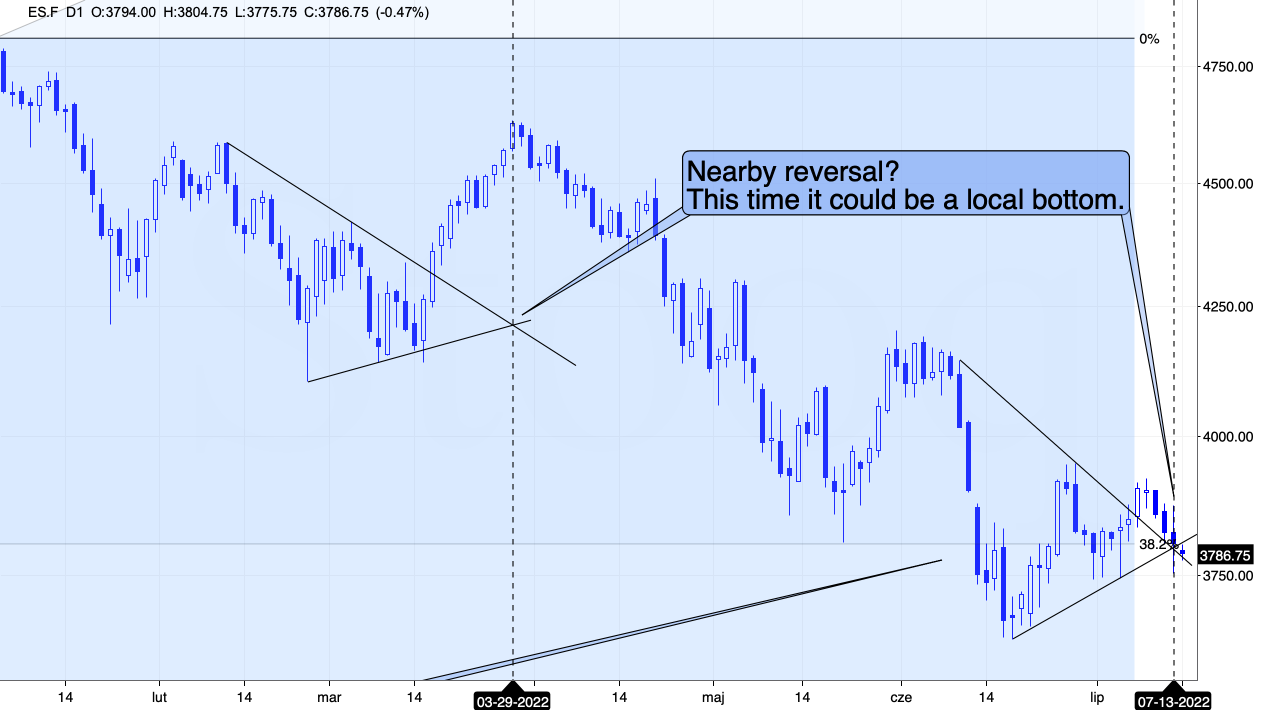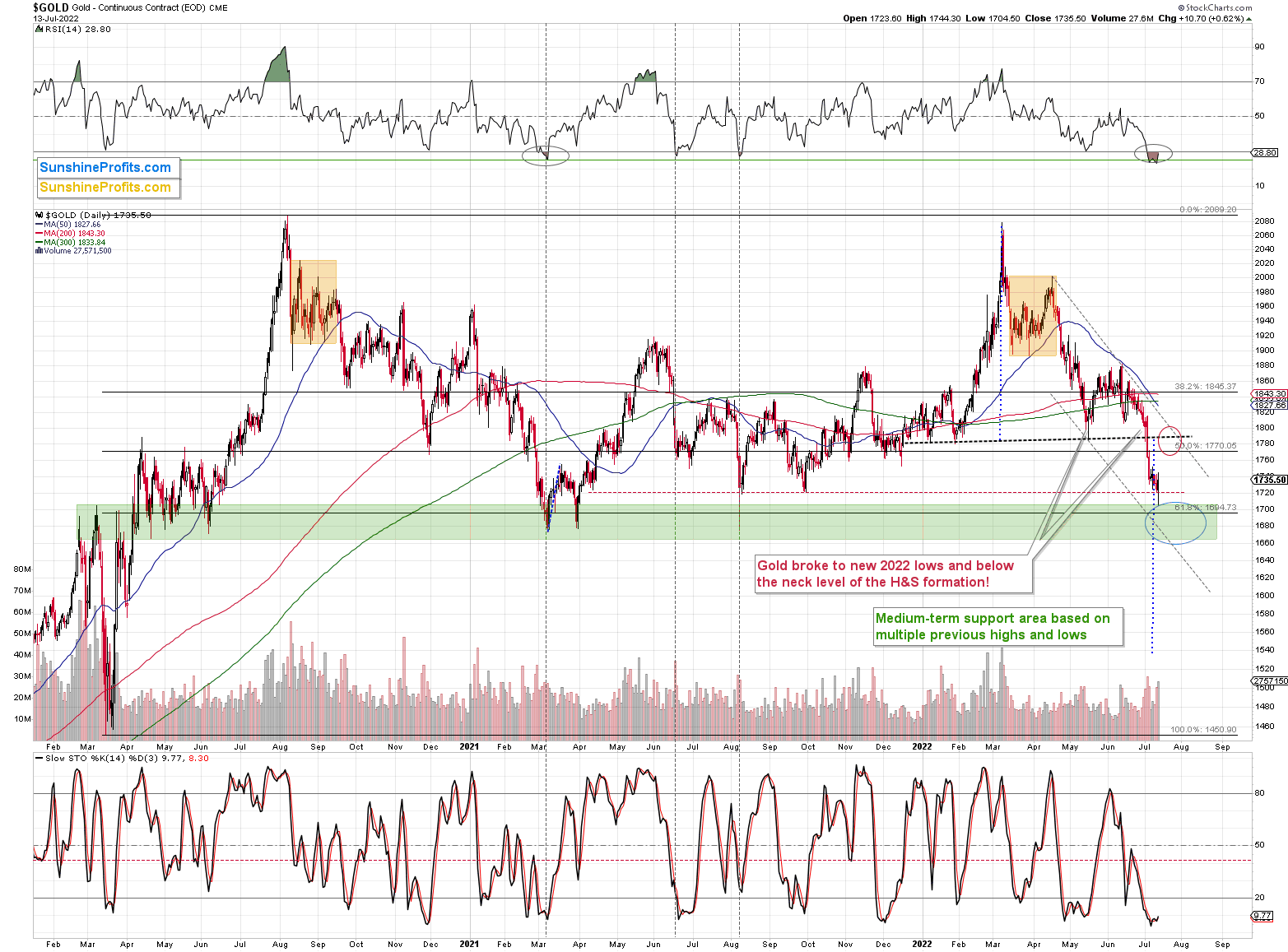tools spotlight

-
Gold Is Getting Ready to Follow in Junior Miners’ Footsteps
July 20, 2022, 9:08 AMAs junior miners continue to rise and the USD keeps falling, it seems like a matter of a short time before gold soars. It only needs a proper trigger.
A Guiding Light
Gold is doing pretty much nothing these days, but junior miners tell us what gold’s going to do next. It’s most likely to rally in the short term.
Why? Because the mining stocks tend to lead gold higher and lower, and looking at the relative performance of both parts of the precious metals sector, we see that this time, miners are already moving higher, while gold is getting ready to follow in miners’ footsteps. Let’s take a closer look at what junior miners (the GDXJ) did recently.
In short, junior miners managed to break above their declining short-term resistance line, and they closed above it for the second consecutive day. If they stay above it today (which is highly likely), the breakout will be confirmed. This is a very bullish indication for the short run.
This is especially the case since it happened shortly after the GDXJ refused to break below the $30 level – rallying back above it after a daily close slightly below it. The invalidation of the tiny breakdown itself was a bullish sign, not to mention that the very bottom – the daily reversal – materialized in huge volume.
The above chart is bullish for the short run, and please note that junior miners are now well above their early-July bottom.
Gold, on the other hand, is not above its early-July low. It’s barely up from its July 14 bottom.
The RSI remains very oversold, suggesting that gold hasn’t started its rally just yet, but that it remains poised to soar. After all, in RSI terms, gold is now more oversold than it was at its 2020 bottom.
Speaking of 2020, gold recently bottomed practically right at its early-2020 high. To be clear, it was one of the levels that created strong support close to the $1,700 level. Either way, this means that gold is likely to rally any day now.
So, what is gold waiting for? Why isn’t it rallying, especially given that the USD Index is declining and the EUR/USD currency pair is rallying?
As a reminder, the EUR/USD pair reversed in a profound way after trying to break below the all-important 1 level. For a brief moment, the U.S. dollar was more expensive than the euro, and it triggered a reversal, just as I had indicated.
Gold Is Waiting
The answer to the why-not question could lie in Europe. More precisely, in the Eurozone and this week’s interest rate decision, which is due tomorrow (Thursday, July 21). It’s not a matter of what will or will not be said and done. It’s a matter of the uncertainty that will be present until it’s known what the status is (for now). Based on that, we could see some chaotic price movement on an intraday basis. However, once a decision is made and the markets know what’s going on, the traders might finally want to enter the trades that they are now allowing themselves to enter right now, adopting the wait-and-see approach.
Please note that the above is just one of the possible triggers for gold price moves, and it could actually be something else that directly triggers the move. What it will be is of relatively small importance. What is much more important is the pressure that has built up for gold to rally. The USDX decreased, and junior miners are already moving higher. The RSI below 30 is like a coiled spring, just waiting to expand rapidly. Given the ECB’s looming decision, it seems that we won’t have to wait long for gold to finally move and correct some of its recent declines.
All in all, it looks like the precious metals sector is going to rally and probably top close to the end of this month as the USD Index pulls back after a sizable rally.
Thank you for reading our free analysis today. Please note that the above is just a small fraction of the full analyses that our subscribers enjoy on a regular basis. They include multiple premium details such as the interim targets for gold and mining stocks that could be reached in the next few weeks. We invite you to subscribe now and read today’s issue right away.
Sincerely,
Przemyslaw Radomski, CFA
Founder, Editor-in-chief -
While the Dollar Retreats, the GDXJ Road to Rally Seems Clear
July 19, 2022, 7:42 AMToday’s technical analysis will be similar to yesterday’s, as we simply either saw a repeat of the previous indication or the situation developed in tune with them.
Let’s start with what I wrote yesterday about the chart featuring GDXJ (junior miners), GDX (senior miners), GLD (gold), and SLV (silver):
Gold, silver, and miners declined heavily in the past weeks, but it seems that they got too low, too fast, and now a quick rebound seems very likely.
On Friday, junior gold miners once again refused to decline below the $30 level, indicating that a rally was probable, which added to the list of bullish signals for the short term.
Interestingly, junior miners are now the strongest part of the precious metals sector (at least among its popular parts).
Junior miners (the GDXJ ETF) are the only ones of the above that just closed above their early-July lows. Senior miners (the GDX ETF) are only a little below their own early-July low, but gold (GLD) and silver (SLV) are much below their respective early-July lows.
Why would junior miners be so strong right now? One simple reason – because they had been so weak in the previous weeks. It’s not only a given market that usually (it’s almost always the case) doesn’t go up or down without periodic corrections, but one market’s relative performance to other markets.
So, what we see here, is not necessarily a reflection of junior miners’ “true strength,” but it’s just that since they have fallen the most, they are now bouncing more visibly. That’s likely it. Still, it seems that choosing junior mining stocks as a proxy for our current long position was a good idea.
Either way, the above chart provides us with one additional important detail.
The thing is that the GDXJ closed on Friday just a little below its declining short-term resistance line. The previous attempt to rally above it was invalidated, but given their relative strength, the recent reversals (one formed on huge volume), and the fact that GDXJ was quick to invalidate a tiny breakdown below $30, all suggest that a move higher is just around the corner.
In fact, looking at GDXJ’s [yesterday’s – that was posted on July 18] performance in today’s early London trading, it seems very likely that it will be able to break above the above-mentioned declining resistance line this time.
Indeed, the precious metals sector moved higher, and the GDXJ broke above its declining resistance line. When we saw something like that previously, it was immediately followed by another decline (and the breakout was invalidated), but we see signs that this time the breakout will be confirmed and then followed by another rally.
For example, even though gold is trading a bit lower than it was trading when I was preparing yesterday’s analysis, the GDXJ (in London trading) is a bit higher (as you can see on both above charts, it’s now 0.1 higher), so junior miners continue to show strength.
Additionally, the USD Index continues to decline in today’s pre-market trading.
This is in perfect tune with what I wrote previously – the USDX reversed in a big way recently while reaching its long-term resistance.
Consequently, my previous comments on the above chart remain up-to-date:
The USD Index has quite likely formed a short-term top here, and it’s now likely to correct. How low would the USD Index be likely to move? Quite possibly to the 104 level or so, as that’s where we have very strong medium-term support. This support level is strengthened by the 1999 high (approximately), the 2002 low, the 2016 high, and the 2020 high – all very important highs.
Additionally, please note that the middle of the year is just around the corner, and that’s when the USD Index usually reverses, and it’s usually the case that those reversals are bottoms. I marked those cases with vertical red dashed lines. So, if the USD Index continues to correct here (and I think that it will), the decline might be rather short-lived.
All in all, it looks like the precious metals sector is going to rally and probably top close to the end of this month as the USD Index pulls back after a sizable rally.
Letters to the Editor
Q: Dear PR,
Below was the YouTube page presented to me today. All of the “experts” got it so wrong. I added the text. I guess that’s what happens when people want free advice. Something is worth exactly what you pay for it. I have a huge admiration for what you have done for me. I am enormously grateful. You said the market would rally last week, so I took a load of other profits from short positions and bought SQQQ. That worked. :D If you have any other observations like that, it would be much appreciated. I intended to buy UUP with a load of cash. If you could indicate when DXY has finished its correction, I’d appreciate it.
PS I hope you are shorting the Polish market. It has TANKED.A: Thank you for the great feedback, and congratulations on your huge gains! Also, congratulations on the recent gains to everyone who’s reading this and who participated in the trades that I’ve been recently describing.
I’ll strive to remain as objective as possible in order to provide you with the analysis that helps you gain even more in the future.
I’ll definitely keep commenting on the forex market (i.e. the USD Index – DXY). At this time, 104 still seems like the most likely short-term downside target.
Q: I just read an article about PSLV. What I thought was interesting is that the article stated that PSLV is actually backed by physical silver, not paper. The writer said that when, not if, the debt ceiling is raised and if inflation resumes an upside move as a result of the increased spending the gold-silver ratio could possibly go from 80sh to around 20sh. That would result in a significant upside since one can buy so many more ounces of silver than gold. Do you have any thoughts on the reasoning behind this concept?
A: Yes, the PSLV owners claim to have physical silver, and while I haven’t inspected the vaults myself, it seems believable based on the documents that they present. As a reminder to other readers, “the paper silver” refers to something that can’t be held in hand and actually used – like a silver futures contract. It’s something that refers to a future purchase (assuming that there will be enough silver that can be delivered after the contract expires, that is).
Well, the debt ceiling has been raised numerous times in the previous years and it didn’t trigger rallies in the precious metals sector and it was accompanied by all sorts of moves in the gold to silver ratio.
Also, the debt ceiling had been increasing between the early 1980s and the mid 1990s, and you know what happened to the prices of precious metals then? They declined.
So, while raising the debt ceiling is a fundamental factor that contributes to the overall favorable picture for the precious metals market in the long run (in terms of years), it tells nothing about even medium-term price moves, let alone short-term price moves.
The things that are much more likely to impact the gold to silver ratio include geopolitical turmoil (gold reacts much stronger than silver) and the developments in the general stock market (silver has more industrial uses, so it’s more connected with the general stock market than gold is), and I’d pay attention to those instead of focusing on the debt ceiling. By the way, the topic of the latter is rather unexciting because, in my opinion, it will simply be raised whenever the debt grows more – the politicians don’t seem to care about it anymore.
However, even though I don’t think the debt ceiling by itself is a good reason to be investing in anything and it’s not really a useful tool for forecasting moves in the gold to silver ratio, I do think that silver will move higher than gold in the long run – in the next several years, that is – but it will be for other reasons.
Q: Please comment on the intensity of COVID cases increasing, and what could occur in the gold PM market and how it could alter the PM market and your projections. How would this affect the USD? This question is asked in relation to your current PMs’ positions and when gold will reach its low.
A: I see very little impact on the markets, if any, and I don’t see any impact on our current (and following) positions.
As I’ve been writing recently, people are not that concerned with COVID anymore – they are concerned with inflation – and the developments regarding it (and interest rates) are much more important from the investment/trading point of view.
In the chart below (courtesy of Google Trends), you can see how people are losing interest in “covid” as a search phrase.
The recent slight upswing didn’t change anything.
On the more fundamental front, while the cases are indeed rising, it’s not really the case with deaths. Charts courtesy of Google.
Please keep in mind the way that the “covid deaths” are measured – when someone dies for some reason, but they had COVID, it’s being counted as a “covid death”. Consequently, it’s not necessarily the case that COVID itself is that dangerous at this time, even though statistics still show many deaths – people die for all sorts of reasons, and if some of them have COVID and it increases the chances of death by very little, they would likely die for the original reason, anyway.
The above, on one hand, and the the dire economic situation in the world (the world aims to tackle inflation while not crashing the economy), makes me think that there will be no major consequences of the recent increase in COVID cases. Lockdowns would be too damaging and any extra support money that would need to accompany them would add gasoline to the inflationary fire, which is the opposite of what’s currently being done through higher interest rates.
Yes, it could develop in all sorts of ways, but let’s keep the “beacon indicator” in mind – what would the politicians do if they wanted to avoid the blame and appear as if they were doing what’s good for the people (what the people request)? At this time, people are very concerned with inflation, so that’s what’s likely to be targeted. The media narrative would be likely to “support” the above (by the way, does anyone still believe in free and independent mass media, anymore?).
Thank you for reading our free analysis today. Please note that the above is just a small fraction of the full analyses that our subscribers enjoy on a regular basis. They include multiple premium details such as the interim targets for gold and mining stocks that could be reached in the next few weeks. We invite you to subscribe now and read today’s issue right away.
Sincerely,
Przemyslaw Radomski, CFA
Founder, Editor-in-chief -
How to Become Strong After a Massive Decline? Ask Gold Miners!
July 18, 2022, 7:49 AMGold, silver, and miners declined heavily in the past weeks, but it seems that they got too low, too fast, and now a quick rebound seems very likely.
On Friday, junior gold miners once again refused to decline below the $30 level, indicating that a rally was probable, which added to the list of bullish signals for the short term.
Interestingly, junior miners are now the strongest part of the precious metals sector (at least among its popular parts).
Junior miners (the GDXJ ETF) are the only ones of the above that just closed above their early-July lows. Senior miners (the GDX ETF) are only a little below their own early-July low, but gold (GLD) and silver (SLV) are much below their respective early-July lows.
Why would junior miners be so strong right now? One simple reason – because they had been so weak in the previous weeks. It’s not only a given market that usually (it’s almost always the case) doesn’t go up or down without periodic corrections, but one market’s relative performance to other markets.
So, what we see here, is not necessarily a reflection of junior miners’ “true strength,” but it’s just that since they have fallen the most, they are now bouncing more visibly. That’s likely it. Still, it seems that choosing junior mining stocks as a proxy for our current long position was a good idea.
Either way, the above chart provides us with one additional important detail.
The thing is that the GDXJ closed on Friday just a little below its declining short-term resistance line. The previous attempt to rally above it was invalidated, but given their relative strength, the recent reversals (one formed on huge volume), and the fact that GDXJ was quick to invalidate a tiny breakdown below $30, all suggest that a move higher is just around the corner.
In fact, looking at GDXJ’s performance in today’s early London trading, it seems very likely that it will be able to break above the above-mentioned declining resistance line this time.
Gold and silver futures are both up in today’s pre-market trading as well, and so is the general stock market. At the same time, the USD Index is down.
This is in perfect tune with what I wrote previously – the USDX reversed in a big way recently while reaching its long-term resistance.
Consequently, my previous comments on the above chart remain up-to-date:
The USD Index has quite likely formed a short-term top here, and it’s now likely to correct. How low would the USD Index be likely to move? Quite possibly to the 104 level or so, as that’s where we have very strong medium-term support. This support level is strengthened by the 1999 high (approximately), the 2002 low, the 2016 high, and the 2020 high – all very important highs.
Additionally, please note that the middle of the year is just around the corner, and that’s when the USD Index usually reverses, and it’s usually the case that those reversals are bottoms. I marked those cases with vertical red dashed lines. So, if the USD Index continues to correct here (and I think that it will), the decline might be rather short-lived.
All in all, it looks like the precious metals sector is going to rally and probably top close to the end of this month as the USD Index pulls back after a sizable rally.
Thank you for reading our free analysis today. Please note that the above is just a small fraction of the full analyses that our subscribers enjoy on a regular basis. They include multiple premium details such as the interim targets for gold and mining stocks that could be reached in the next few weeks. We invite you to subscribe now and read today’s issue right away.
Sincerely,
Przemyslaw Radomski, CFA
Founder, Editor-in-chief -
Gold Stocks Are Heavily Oversold - A Rebound Is Likely Soon
July 15, 2022, 9:34 AMGold stocks declined by about 31.5%, which perfectly fits my previous analogy to 2008. If history is to rhyme, we can expect a corrective upswing soon.
2008, Is That You Again?
History tends to repeat itself. Not to the letter, but in general. The reason is that while economic circumstances change and technology advances, the decisions to buy and sell are still mostly based on two key emotions: fear and greed. They don’t change, and once similar things happen, people’s emotions emerge in similar ways, thus making specific historical events repeat themselves to a certain extent.
For example, right now, gold stocks are declining similarly to how they did in 2008 and in 2012-2013.
The Russian invasion triggered a rally, which was already more than erased, and if it wasn’t for it, the self-similarity would be very clear (note the head-and-shoulders patterns marked with green). Since the latter happened, it’s not as clear, but it seems that it’s still present. At least that’s what the pace of the current decline suggests.
I used a red dashed line to represent the 2008 decline, and I copied it to the current situation. They are very similar. We even saw a corrective upswing from more or less the 200-week moving average (red line), just like what happened in 2008.
We saw a breakdown to new short-term lows, which means that the volatile part of the slide is likely already underway.
Moreover, last week, I commented on the above chart in the following way:
On a short-term basis, we see a short-term (only) downside target of around 200. That’s about 10% below yesterday’s (Thursday’s) closing price. There are several reasons for it:
- It’s a round number, and those tend to be more important psychologically than other numbers.
- That’s where we have the rising medium-term support line based on the 2016 and 2018 lows. The temporary move below this line triggered a massive rally in 2020.
- That’s where we have the 61.8% Fibonacci retracement level based on the entire 2016-2020 rally.
Not Every Fall Must Be Bearish
The 200 target was just reached yesterday. In fact, what happened was even more bullish than that – we saw a tiny move below this level – to 199.22, and then a comeback and a close visibly above 200 – at 204.67.
Ultimately, the HUI Index moved lower yesterday, and many will view this simple fact as something bearish. However, doing that would be a “rookie mistake” – after all, major bottoms can only form after declines, right? My point is that a move higher or lower is not bullish or bearish by itself. It’s the context that adds meaning to a certain price move. In this case, a major support level was reached while the HUI Index was already heavily oversold.
In fact, based on the RSI, the gold stocks are even more oversold than they were at their 2020 bottom!
Consequently, a rebound here is a likely short-term outcome.
All right, let’s zoom in and see how mining stocks declined in 2008.
Back then, the GDXJ ETF was not yet trading, so I’m using the GDX ETF as a short-term proxy here.
The decline took about 3 months, and it erased about 70% of the miners’ value. The biggest part of the decline happened in the final month, though.
However, the really interesting thing about that decline – that might also be very useful this time – is that there were five very short-term declines that took the GDX about 30% lower.
I marked those declines with red rectangles. After that, a corrective upswing started. During those corrective upswings, the GDX rallied by 14.8-41.6%. The biggest corrective upswing (where GDX rallied by 41.6%) was triggered by a huge rally in gold, and since I don’t expect to see anything similar this year, it could be the case that this correction size is an outlier. Not paying attention to the outlier, we get corrections of between 14.8% and 25.1%.
The interesting thing was that each corrective upswing was shorter (faster) than the preceding one.
The first one took 12 trading days. The second one took seven trading days. The third one took 2 trading days, and the fourth and final one took just 1 trading day.
Fast forward to the current situation. Let’s take a look at the GDXJ ETF.
The GDXJ ETF declined by 32.4% and then corrected – it rallied by about 20.3%. The corrective upswing took 14 trading days.
Now, it has declined by about 31.5%.
The above is in perfect tune with the previous patterns seen in the GDX during the 2008 slide.
I previously wrote the following:
What does it tell us? It indicates that history can be rhymed, and while it will not be identical, we should pay attention to the indicators that worked in 2008. The next corrective upswing (a notable one, that is) might start when the GDXJ ETF declines by about 29-35% from its recent top. To clarify, I don’t claim that the above technique would be able to detect all corrective upswings, or that I aim to trade all of them. For instance, in my view, it was a good idea to enter a long position on May 12 and switch to a short position on May 26, but I wasn’t aiming to catch the intraday moves.
Again, yesterday’s bottom formed about 31.5% below the recent high, which perfectly fits my previous estimate and the analogy to 2008.
Based on how long the corrective upswings took in 2008 and how long the recent one took, the upcoming corrective upswing is likely to take between 5 and 10 trading days. If the bottom formed yesterday, which seems likely as the GDXJ ETF is already up by over 1% in today’s London trading, then we can expect the next local top to form within 1-2 weeks. In other words, it seems that the corrective upswing is likely to end in the next part of July – probably in its final week.
Back in 2008, the counter-trend rallies varied greatly in their magnitude, but please keep in mind that back then, the decline was very much news-based – Lehman Brothers’ collapse, etc. This time, the decline is more measured, so declines and corrections are more measured as well.
While back in 2008, during the first correction, the GDX gained only 14.8% and during the second one it gained a sizable 41.6%, this time the first rally provided a measured 20.3% increase. If the upcoming correction is also measured, then the GDXJ might also rally by about 20%.
If yesterday’s intraday low was indeed the final bottom, then the starting price would be $28.88 and a price 20% higher is ~$34.66, which fits my target area for the upcoming correction.
Naturally, the above is up-to-date only at the moment of writing these words (Friday, July 15th), but I’ll keep my subscribers informed with regard to any changes.
Thank you for reading our free analysis today. Please note that the above is just a small fraction of the full analyses that our subscribers enjoy on a regular basis. They include multiple premium details such as the interim targets for gold and mining stocks that could be reached in the next few weeks. We invite you to subscribe now and read today’s issue right away.
Sincerely,
Przemyslaw Radomski, CFA
Founder, Editor-in-chief -
Don’t Worry, That’s a Reversal - Gold Is on Its Way to $1,800
July 14, 2022, 9:01 AMAfter the USD dropped in 2021, there was a price increase in both gold and mining stocks. If the situation repeats, gold is likely to continue rising.
And, of course - that was a reversal, folks!
Bullish Implications
Let’s start today’s analysis with what I wrote yesterday about the general stock market:
Would a 4-index point decline in the USD Index be likely to trigger a rally in gold and junior mining stocks? Yes, and as far as the latter are concerned, if the general stock market moves higher, the rally in them could be quite visible.
Interestingly, the stock market is right above the combination of short-term support levels.
What’s even more interesting is that we have a triangle-vertex-based reversal there today. To show that this technique is useful also in the case of the S&P 500 futures, I marked the previous similar triangle and the reversal that it triggered. Back then it was a local top, but since we’re seeing declines now, it’s much more likely that the reversal will actually be a short-term bottom.
It could be the case that markets rally based on today’s CPI statistics, or that they decline first, reverse, and then rally. Either way, today’s CPI numbers release corresponds quite well to the technical indication that we have about today (that we’re likely to see a reversal).
In short, that’s exactly what happened. I’ll discuss the CPI itself in the following part of the analysis, but for now, let’s focus on what happened on the technical front.
The S&P 500 futures declined substantially, moving very close to their previous July lows (at about 3,750) and then they moved back up. They still ended the day lower, but the reversal was quite profound.
Stock futures are down in today’s pre-market trading but not significantly so, and given the fact that yesterday’s reversal took place at the triangle-vertex-based reversal, today’s move lower is likely to turn into a short-term rally shortly. If it doesn’t happen today, it’s likely to happen soon.
We also see something similar in gold’s pre-market trading, and the implications are just as bullish. Gold futures are down by about $20, but they are well above yesterday’s intraday low of $1,704.50.
On the above gold chart, you can see that gold just touched the upper border of my original target area for this short-term decline, and then moved back up, closing above the red dashed line. This way, both targets were reached, and we saw a big-volume reversal that confirmed that the short-term trend has just most likely changed.
Gold on the Rise?
How high is gold likely to rally from here?
To about $1,770-1,800. That’s where we have several resistance levels, including the neck level of the previously broken head-and-shoulders pattern. The silver price is likely to rally too – in the near term, that is.
Additionally, please note the situation in the RSI in the upper part of the chart. What we saw recently is very similar to what we saw in March 2021, only this time the RSI indicated slightly more oversold conditions.
How high did gold rally back then? Well, it bottomed and kept on rallying for months, but it doesn’t mean that exactly the same thing is likely to happen now. You see, the further price moves from the “signal”, the less likely the price performance is likely to be repeated. So, while the initial several days are quite likely to be similar, the following few weeks might also be similar, but it’s a rather weak indication. The following months might develop completely differently.
Let’s focus on the short-term indications that are most likely to be meaningful.
After bottoming in March 2021, gold moved up rather quickly, and it stopped only after it moved close to the previous lows that provided resistance. That’s exactly what I expect to see this time too. Gold could move visibly higher in the near term, topping close to its resistance levels or between them.
Thank you for reading our free analysis today. Please note that the above is just a small fraction of the full analyses that our subscribers enjoy on a regular basis. They include multiple premium details such as the interim targets for gold and mining stocks that could be reached in the next few weeks. We invite you to subscribe now and read today’s issue right away.
Sincerely,
Przemyslaw Radomski, CFA
Founder, Editor-in-chief
Gold Investment News
Delivered To Your Inbox
Free Of Charge
Bonus: A week of free access to Gold & Silver StockPickers.
Gold Alerts
More-
Status
New 2024 Lows in Miners, New Highs in The USD Index
January 17, 2024, 12:19 PM -
Status
Soaring USD is SO Unsurprising – And SO Full of Implications
January 16, 2024, 8:40 AM -
Status
Rare Opportunity in Rare Earth Minerals?
January 15, 2024, 2:06 PM


